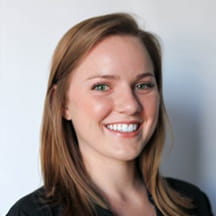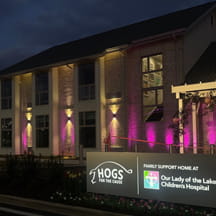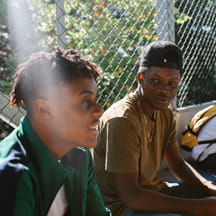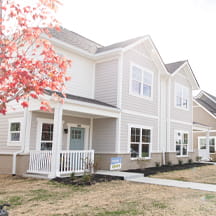Children's hospitals are looking for ways to not only engage their communities but also take advantage of integral relationships outside organizations have with patient populations. Here are three examples of community partnerships that are connecting community members to the resources they need.
Reducing asthma admissions
Dayton, Ohio, sits at the heart of the Miami Valley and the intersection of several major highways. Just to the east is Columbus, south is Cincinnati and west Indianapolis. The Asthma and Allergy Foundation of America dubs it the Ohio Valley Asthma Belt. Five Ohio cities are listed in the 20 worst cities for people with asthma. Out of 100 U.S. cities ranked from worst to best, Dayton is No. 2.
"Part of it is poverty, lack of insurance and poor air quality," says Jessica Saunders, director of community engagement at Dayton Children's. "We are known for poor air quality because of where we're located."
Asthma is one of the biggest reasons kids come to Dayton Children's emergency department (ED). In fiscal year 2019, Dayton Children's admitted or observed 807 kids for asthma, and there were 1,990 asthma-related ED visits. Asthma pops up as a primary issue on every community health needs assessment.
"About 20% of a child's health has to do with the clinical care they receive," Saunders says. "If that family has a home with mold in the walls, medication will do nothing. If the family can't drive to the pharmacy, they're not going to get a prescription filled."
Dayton's poverty rate is 2% higher than the national average and finding safe, affordable housing is a recognized challenge for the city. "Asthma does not discriminate and varying social needs make it harder for families to manage their child's asthma," Saunders says. "We would like to improve their quality of life and reduce asthma admissions and ED visits."
The program
The Dayton Asthma Alliance is a group of 17 organizations, including Dayton Children's, that are working together to achieve better outcomes for kids with asthma. Following a community organizing structure called collective impact, Dayton Children's is the backbone organization that convenes the group of partners. Each partner brings their own funding and hosts many of their own initiatives, driving toward the shared goals.
The Dayton Asthma Alliance started as a conversation between the children's hospital, Public Health Dayton & Montgomery County and Dayton Public Schools. Legal Aid of Western Ohio joined shortly thereafter to assist families with a child with asthma exacerbated by housing-related issues.
When the hospital's community health worker identifies a family that needs to leave their home, Legal Aid works with the landlord on the family's behalf. For example, if the problems can't be fixed, Legal Aid navigates breaking the lease without the family paying a penalty. "We've tried to find what happens beyond the walls of the hospital that the clinical team can't be responsible for, but our partners can fill the gap," Saunders says.
As part of the Alliance, Dayton Public Schools brought the American Lung Association's Open Airways program to fourth graders to teach asthma management, including warning signs of an asthma attack and avoiding triggers. The district also introduced the Mobile Health Unit that sees about 50 kids at school each month.
Kids can receive additional asthma-management education, asthma action plans, doctor's referrals or medication forms. The Mobile Health Unit removes access to care barriers, bringing care to the patient without parents missing work or finding transportation.
The data
Each partner collects its own data on initiatives they own, making it a challenge to understand outcomes data. Saunders says one goal is to establish shared measurement and reinforce that individual organizations are having an effect. "It's hard to get a snapshot of all the children with asthma because we only see hospitalization data," Saunders says. "Data are the biggest challenge because we want to be able to track these kids, but when they're touching multiple systems, it's hard."
Additionally, preventive efforts as part of the Asthma Alliance are near impossible to measure. In 2018, 53 kids and 15 parents were trained in Open Airways, but Dayton Children's can't assume these kids are the ones ending up in the ED. Nonetheless, in terms of sheer volume of kids being touched by the Asthma Alliance, Open Airways is considered a success.
"We try to bridge the clinical with the community and make sure we're working together," Saunders says. "If we're going to address the social determinants of health and these chronic conditions, we have to involve the other sectors and have the relationships. We know our alliance is good by the number of people that stay after meetings, exchange cards and have conversations. That's where the real work happens."
Promoting safe sleep for infants
When Children's Mercy Kansas City conducted its 2018 community health needs assessment, the organization asked about 1,000 local parents how they put their baby to sleep: 30% of parents said on their stomach, and 8% said on their side. The last two assessments led to similar conclusions.
"We kept hearing from the community that there was a challenge in the availability of portable cribs," says Margo Quiriconi, director of community health initiatives at Children's Mercy. "Many agencies that were connecting with families with infants and providing safe sleep education didn't have access to portable cribs or would run out frequently."
Enter, Sleepyhead Beds. The organization collects donated mattresses and bedding for Kansas City families in need. Prior to a partnership with Children's Mercy, Sleepyhead Beds accepted beds of all sizes—except portable cribs. Because of safety regulations, the organization was hesitant to get involved in bed distribution for children under two.
Upon developing a formalized partnership, Children's Mercy connected Sleepyhead Beds with other community agencies that played a role in safe sleep practices. "The staff at Sleepyhead Beds had safe sleep training," Quiriconi says. "They wanted to understand what safe sleep was and why portable cribs were an option for families, and how they could best source them."
The program
Once the Sleepyhead Beds warehouse was stocked with portable cribs and the three-person team was trained on safe sleep practices for babies, the nonprofit could start distributing through community agencies. "Sleepyhead Beds did not want to be a distribution center for families," Quiriconi says. "If a family is needing a bed, they probably have a need for other types of services and support in their journey. That's why Sleepyhead Beds values connections to other agencies."
Sleepyhead Beds distributes portable cribs based on referrals from other community organizations that work with children—home visiting programs, social services or public schools. The portable crib distribution operates differently than bed distribution.
When a family is referred for a bed, they typically receive one bed per person who needs one in the home, and there's no required education on safe sleep. For a portable crib, however, referrals must come from an entity that provides safe sleep education. The agency places an order with Sleepyhead Beds, receives the cribs and provides them to the family with information on safe sleep practices for the child.
The data
Sleepyhead Beds receives a Community Benefit Capacity Building Grant from Children's Mercy and, as part of the partnership, reports to the hospital on how many portable cribs are given out and from which agencies.
"The organization has a number of families that are being referred for beds for a 5-year-old, and those families are also saying they don't have a place for their infant to sleep," Quiriconi says. "Sleepyhead Beds is connecting those families to an organization that can give them the safe sleep support they need."
Quiriconi is working toward getting other community organizations that receive funding for portable cribs to turn over those funds to Sleepyhead Beds. "If Sleepyhead Beds can consolidate the funding, they could buy more cribs," Quiriconi says. "They have the storage space, and they can do bulk purchasing. There are a lot of advantages."
Primary care in the community
Washington, D.C.'s Ward 8 has a poverty rate more than double the national average and significantly higher than the greater D.C. area. The number of kids living in poverty decreased nearly 3% for the greater metro area between 2011 and 2015, but Ward 8 experienced a 1.3% increase in childhood poverty.
"Ward 8 has the most residents under the age of 18 and socioeconomically has had some of the lowest health outcomes," says Alsan Bellard Jr., M.D., medical director of Children's National THEARC, pronounced "the arc." Many families in the community have difficulty accessing care for financial or geographic reasons. Many don't have health insurance.
The program
THEARC consists of three buildings on 16.5 acres in the heart of Ward 8, housing 14 nonprofit organizations, including Children's National THEARC. Children's National Hospital has supported the health center since day one, employing the facility's eight physicians, one nurse practitioner and visiting specialists, and financially supporting all services via reimbursements or philanthropy.
The network of organizations paves the way for comprehensive care across all areas of wellness. Children's National will accept anyone between the ages of 0 and 23. "In addition to general pediatric care, we have dental care, mental health services and access to subspecialty care from rotating specialists who come from the hospital to our primary care center," Bellard says.
Children's National THEARC partnered with Phillips Collection, a THEARC art organization, to offer Create While You Wait. While patients are waiting to see a physician, they can create art projects. The health center also partnered with the Washington School for Girls to provide health education for girls in third through eighth grades.
The Meditation Center, supported by the David Lynch Foundation, teaches transcendental meditation, and physicians in the health center often refer families and other staff members downstairs to learn stress management.
Bellard says on-campus partnerships keep physicians interacting with patients, even outside of the doctor's office. Bellard and his team are regulars at school events, like ballet and music performances. "It's one thing for kids to come and receive medical care, but it's an added bonus that they can be exposed to their same physician throughout campus," Bellard says. "It's not uncommon for us to support them in after-school activities."
The data
Bellard says patient visits are increasing each year. "Having access to primary care is important, particularly for populations that have historically been under served," Bellard says. "This allows us in the long run to address many social determinants of health."
A study examining how families use THEARC showed 25% of families were enrolled in two or more programs, and 72% of Children's National THEARC patients use at least one other program on campus.
Bellard says the future of Children's National is to measure specific outcomes and the influence of its services on the community. "The 20-minute doctor's visit has always been an important point of health," Bellard says. "But more important are the opportunities kids and families have in their communities once they leave here. It's a way to provide holistic care to families."



